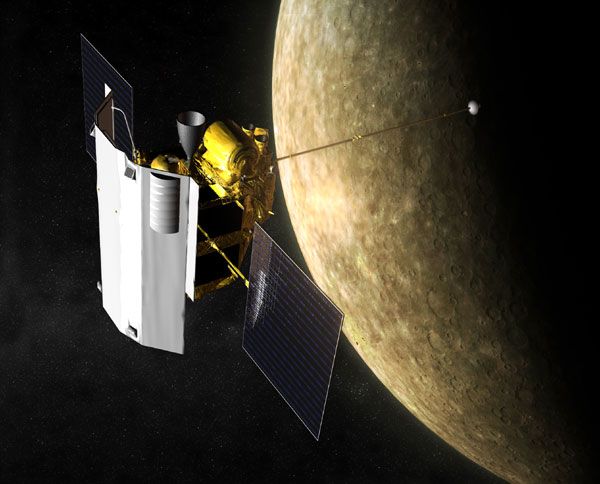
NASA / Johns Hopkins University Applied Physics Laboratory / Carnegie Institution of Washington
MESSENGER Update...
****
MESSENGER Begins Historic Orbit around Mercury (Press Release)
At 9:10 p.m. EDT, engineers in the MESSENGER Mission Operations Center at the Johns Hopkins University Applied Physics Laboratory (APL) in Laurel, Md., received the anticipated radiometric signals confirming nominal burn shutdown and successful insertion of the MESSENGER probe into orbit around the planet Mercury.
The spacecraft rotated back to the Earth by 9:45 p.m. EDT, and started transmitting data. Upon review of these data, the engineering and operations teams confirmed that the burn executed nominally with all subsystems reporting a clean burn and no logged errors.
MESSENGER’s main thruster fired for approximately 15 minutes at 8:45 p.m., slowing the spacecraft by 1,929 miles per hour (862 meters per second) and easing it into the planned eccentric orbit about Mercury. The rendezvous took place about 96 million miles (155 million kilometers) from Earth.
"Achieving Mercury orbit was by far the biggest milestone since MESSENGER was launched more than six and a half years ago," says MESSENGER Project Manager Peter Bedini, of APL. "This accomplishment is the fruit of a tremendous amount of labor on the part of the navigation, guidance-and-control, and mission operations teams, who shepherded the spacecraft through its 4.9-billion-mile [7.9-billion-kilometer] journey."
For the next several weeks, APL engineers will be focused on ensuring that MESSENGER’s systems are all working well in Mercury’s harsh thermal environment. Starting on March 23, the instruments will be turned on and checked out, and on April 4 the primary science phase of the mission will begin.
"Despite its proximity to Earth, the planet Mercury has for decades been comparatively unexplored," adds MESSENGER Principal Investigator Sean Solomon, of the Carnegie Institution of Washington. "For the first time in history, a scientific observatory is in orbit about our solar system’s innermost planet. Mercury’s secrets, and the implications they hold for the formation and evolution of Earth-like planets, are about to be revealed."
MESSENGER (MErcury Surface, Space ENvironment, GEochemistry, and Ranging) is a NASA-sponsored scientific investigation of the planet Mercury and the first space mission designed to orbit the planet closest to the Sun. The MESSENGER spacecraft launched on August 3, 2004, and after flybys of Earth, Venus, and Mercury will start a yearlong study of its target planet in March 2011. Dr. Sean C. Solomon, of the Carnegie Institution of Washington, leads the mission as Principal Investigator. The Johns Hopkins University Applied Physics Laboratory built and operates the MESSENGER spacecraft and manages this Discovery-class mission for NASA.
Source: MESSENGER Mission Website
****

No comments:
Post a Comment